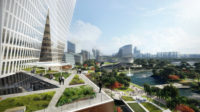Design Roulette: Architects Set Loose in the World






A discussion of design and geography at the Architectural Association in London this spring turned into an examination of difference and uniformity in the work of architects practicing globally. Presented by Asia Design Forum (ADF), a nonprofit think tank, the event was the sixth in a series of Design Roulettes held in different cities since 2010 and the first one outside of Asia. “So many buildings in Asia today are designed in places like London or New York that we thought it made sense to bring this on-going conversation to the U.K.,” said Ken Yeang, a director of ADF.
Christopher Lee, a principal at Serie Architects, which has offices in London, Mumbai, and Beijing, noted that the drive to create buildings that stand out has, ironically, made many cities around the world feel the same. Look at the skylines of fast-growing cities and you’ll find tall buildings screaming for attention but still getting lost in the crowd. That’s because many architects try to create difference out of novelty, using extreme forms to establish identity, said Lee. “Globalization, though, is not new,” he stated, showing a photograph of one of Le Corbusier’s buildings in Chandigarh. Examining Corb’s work in Chandigarh, Lee described it as “both ancient and modern, both universal and specific.”
Responding to Lee, Paul Finch, program director of the World Architecture Festival and deputy chairman of the UK Design Council, asked, “Why does global capital demand novelty rather than innovation?” Lee answered that most big clients just want buildings that look different and don’t want to spend the time or money on design that goes beyond the superficial.
Emily So, a civil engineer and lecturer at the department of architecture at the University of Cambridge, offered a different perspective on design and geography—presenting a map of the world with cities at risk of earthquakes. A satellite photo of Earth at night showed that many cities in high seismic areas are also some of the biggest and fastest growing. “We have a fatal attraction with building in dangerous seismic zones,” noted So. As a result, architects and engineers in these areas have a responsibility to design new buildings and retrofit old ones in ways that accommodate the severe stresses of earthquakes. Culture and politics, though, can make this more difficult, especially when it comes to writing and enforcing building codes and providing funding for seismic upgrades.
“Global architecture is about exporting ideas and creating brand names,” stated Mustafa Chehabeddine, a design principal in the London office of Kohn Pedersen Fox. But at the same time, architects need to respond to local culture and conditions. For example, at a new 40-million-passenger terminal complex at Abu Dhabi International Airport, Chehabeddine’s team at KPF is using “the texture and grain” of the building—its materials and surfaces—to connect it to its particular context.
Melissa Woolford, who runs a consultancy firm called Nous Collaborative and is setting up the Museum of Architecture in London, challenged attendees to rethink the way they practice architecture. Instead of using only a fee-for-service model, can architects learn from businesses such as McDonalds and Netflix and adopt aspects of the franchise or subscription models? For example, subscription businesses establish on-going relationships with their clients or customers, something that might help architects during periods of weak economic activity.
Although it may include different stops today, the “grand tour” remains a deeply rooted tradition among architects, noted Sam Jacoby, an architect and the director of the Projective Cities program at the Architectural Association. From Sir John Soane on the Continent to Venturi and Scott Brown in Las Vegas and Rem Koolhaas in Lagos, architects keep exploring the world in search of “the exotic,” said Jacoby. But we usually see what we expect to see, bringing our own particular perspective and cultural baggage with us. Many architects, stated Jacoby, “use geography as a means of disciplinary appropriation.”
In the 21st century, we can travel the world via the Internet, said Shahira Fahmy, an Egyptian architect currently working as a visiting professor at Columbia’s Graduate School of Architecture, Planning, and Preservation. And now that Google is releasing old maps dating back to 2007, we can travel back in time and see how places have changed in the course of the past seven years—pursuing “an archaeology of the recent past.” For example, if we look at Cairo, Fahmy’s hometown, we will notice the enormous growth at the city’s periphery since 2007. “The built environment reflects changes in society and politics,” Fahmy said.
“When architects start practicing abroad, what happens?” asked Finch. Some architects find themselves working outside their stylistic comfort zone, he noted, “which can push them in new directions.” He cited Cesar Pelli and the Petronas Towers in Kuala Lumpur as an example of an architect expressing himself in a new way in response to a foreign context. “But if you’re a brand,” such as Zaha Hadid or Frank Gehry, foreign clients don’t really want you to change, said Finch. A third response to a new context is the one taken by Wilkinson Eyre in its Gardens on the Bay in Singapore. In this project, the British firm brought its ideas of sustainability to the tropics, exploring ways of reducing energy use in a set of glass-and-steel greenhouses.
For more information on the London Design Roulette and previous ones held in Singapore, Hong Kong, Shanghai, Kuala Lumpur, and Beijing, visit asiadesignforum.org.





